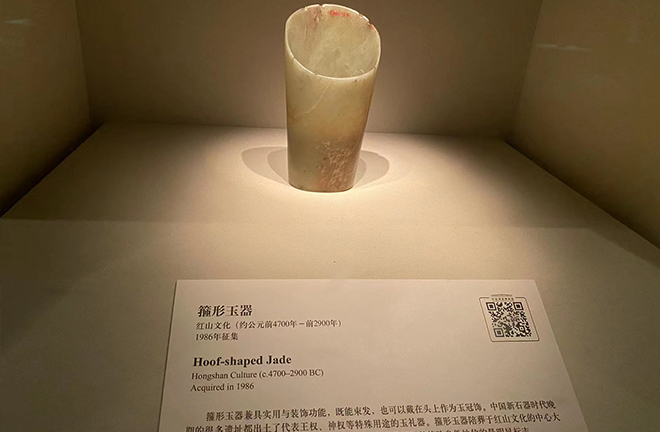
A hoof-shaped jade artifact dating to the late Neolithic Age displayed at the National Museum of China Photo: Chen Mirong/CSST
QINGDAO—Increasingly rich archaeological findings show that the production and use of stone tools and jade ware was an important marker of the progress of human civilization, especially civilizational development in East Asia. On July 9 and 10, the Shandong University Qingdao International Forum on Archaeology of Traditional Industry was held in Qingdao, Shandong Province. Archaeologists from China, Japan, and South Korea discussed the early stone and jade culture in East Asia from the perspectives of different regional civilizations, revealing the complex process of human societies.
Prehistoric processing techniques
The processing and use of stone artifacts and bronzeware is regarded by the archaeological community as a mark of stages in the course of early human civilization, corresponding to the Stone Age and the Bronze Age.
Bai Yunxiang, a chair professor at Shandong University, said that the Neolithic Age, approximately more than 10,000 years to 4,000 years before present, witnessed all-around development of China’s stone and jade handicraft, with grinding as the main technique.
Whang Changhan, director of the Ulsan Institute of Cultural Properties in South Korea, noted that stone tool making techniques in South Korea underwent changes from the Paleolithic, Neolithic, to the Bronze ages. In the Neolithic Age with limited demand for stone implements, large labor pools engaged in production yet with low efficiency. With little risk of damage, rubbing and cutting was a popular technique. Entering the Bronze Age, with increasing demand for farming, people began to explore the more efficient bipolar percussion flaking technique, forming a new stone tool production system.
Nobuhiko Kamijo, a professor at Hirosaki University in Japan, noted that the bipolar technique was also adopted for the stone cones unearthed from the Sotomeyachi site in the late Jomon Period (c. 12,000–300 BCE) in Japan.
Regarding jade, China is among the earliest civilizations in the world to process and use jade, and jade remains were frequently unearthed in many sites dating to the period from prehistoric times to the Shang (c. 16th–11th century BCE) and Zhou (c. 11th century–256 BCE) dynasties.
The Huangshan Archaeological Site in Henan Province, which was rated as one of the top ten new archaeological discoveries in China in 2021, is a culturally rich Neolithic site. Among other findings, the remains of a grand-scale jade processing workshop were the most amazing discovery. The unearthed millstone piers, jade materials, semi-finished jade artifacts, and jade production tools exhibit jade-making scenes at that time.
“The discovery of the jade workshop at the Huangshan site fills the gap in the Neolithic jade handicraft system in the Central Plains and the middle reaches of the Yangtze River,” said Ma Juncai, a research fellow from the Henan Provincial Institute of Cultural Heritage and Archaeology.
Reflecting cultural interactions
Since prehistoric times, an advocacy for jade culture had been fostered in East Asia. Jade handicraft relics have unveiled exchanges and interactions between regional cultures. Relics and ruins from three Neolithic cultures–the Yangshao Culture (c. 5,000–3,000 BCE), Qujialing Culture (c. 3,300–2,600 BCE), and Shijiahe Culture (c. 3,000–1,900 BCE)–were found in different earth layers at the Huangshan site, located in the Nanyang Basin in Henan. Clear traces of cultural exchanges and interactions between China’s northern and southern cultures, the Yangtze River and Yellow River civilizations, were left in this special geographical unit.
Given the uniqueness and distinctiveness of the Dushan Jade, a specialty of Dushan in Nanyang, used in the jade workshop of the Huangshan site, archaeologists conjectured that jade “made in Huangshan” had been circulated in a wide range of areas at that time.
Yu Xiyun, a professor of archaeology from Wuhan University, noticed that jade ware similar in appearance to jade materials from the Huangshan site was common in some upper cultural layers of the Qujialing site in Hubei Province. He said that the jade artifacts of the Qujialing Culture reveal important connotations of early civilization in the middle reaches of the Yangtze River, and the Huangshan site provides information for understanding the Qujialing site.
Yu believes that lower-layer cultures of the Qujialing site gradually expanded westward, and were involved in prehistoric cultural integration in the middle reaches of the Yangtze River. The northward spread of the Qujialing Culture, the westward extension of the Dawenkou Culture (c. 4,500–2,700 BCE), and the interaction between the two might be related to jade resources in Nanyang.
The discovery of numerous jade objects at the Liangzhu site in Zhejiang Province is also eye-catching. Several jade ware production centers have been found in the Liangzhu site, and their products were spread all over areas surrounding the Taihu Lake and beyond.
“Jade handicraft exerted significant impact on Liangzhu society,” said Guo Mingjian, a professor of history at Jinan University in Guangdong Province. The distribution of jade artifacts in the Liangzhu Culture (c. 3,300–2,300 BCE) reflects the external spread of certain regimes’ presence and religious concepts, as well as the attitudes of different places towards this proliferation. The jade handicraft industry under the control of the powerful regimes was instrumental to political rivalry in the society of Liangzhu, and meanwhile it became an unpredictable variable in the development of Liangzhu society.
Edited by CHEN MIRONG

